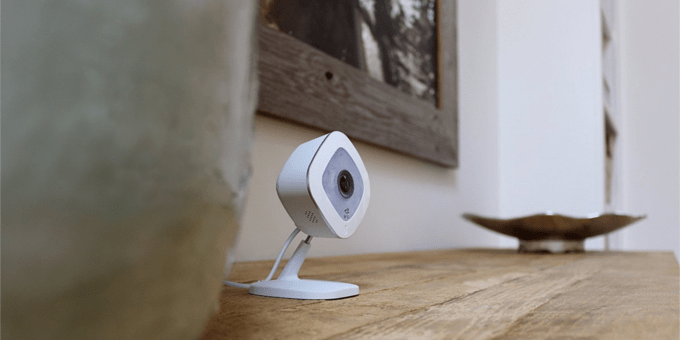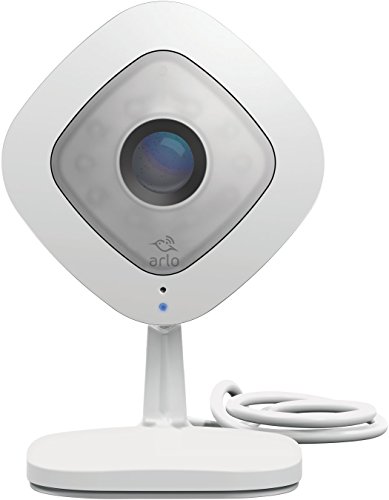While both the Arlo Baby and Arlo Q have their perks, the Arlo Baby is specifically tailored to keep an eye on babies, with Baby Crying Detection and a Smart Music Player.
Within NETGEAR’s Arlo brand, you’ll find products that are intended for different uses — from portable LTE cameras like the Arlo Go, to more traditional and high-end cameras like the Arlo Pro 2. The Arlo Baby is a more niche product, but it’s definitely a little more unique than the more general Arlo Q.
Arlo Baby vs. Arlo Q — Differences
-
Difference #1: Field of View – The first that jumps out when comparing the Arlo Baby vs. Arlo Q is the differences in field of view.
The default view for the Arlo Baby is 110°, but that can be adjusted down slightly as well as up to 130°. The ability to adjust the range is great, but you’re likely better off keeping the camera at its default view. At either extreme, you’ll likely see some image distortion in the Arlo Baby’s videos and pictures.
The Arlo Q has a static 130° field of view, which should be more than sufficient to monitor the average room.
-
Difference #2: Power Options – The primary way you’ll power your Arlo Baby is through an AC plug, but the included 2440mAh rechargeable battery allows you to disconnect it from power for short-term monitoring. On a single charge, you’ll generally get 3-6 hours of battery life, but that may be extended in the future as Arlo continues to optimize the power supply. During the day, the camera should last the full 6 hours, but expect a reduced runtime at night due to the increased power demands of the night vision LEDs.
While the Arlo Baby might only have short-term battery capabilities, it’s still miles ahead of the Arlo Q that only works with AC power.
-
Difference #3: Sound Detection – Both cameras feature sound detection, but the Arlo Baby’s detection is a little more specialized. In addition to alerting you of sounds in general, the camera’s Baby Crying Alert can provide a specific notification if it senses your baby crying.
-
Difference #4: Night Vision – In terms of night vision, both cameras excel in different areas. The Arlo Baby does a better job of lighting up the picture with 940nm LED vs. the Arlo Q’s 850nm LEDs. However, the Arlo Q can see further into the distance with a range of 25 feet vs. the Baby’s 15.
It’s difficult to rank them as better or worse. Since the Arlo Q is a security camera, that extra distance is important, while a clear and bright picture is more important for monitoring your baby through the night. It’s really going to depend on which you value most.
-
Difference #5: LED Lights – One of the cooler perks of the Arlo Baby is the inclusion of the Smart Multi-Colored Night Light. This LED allows you to choose from thousands of different colors as well as adjust the brightness and warmth for the perfect ambiance in your baby’s room.
The Arlo Q features no such feature.
-
Difference #6: Smart Music Player – Lull your baby to sleep with white noise, lullabies, or even the sound of your own voice using the Arlo Baby’s Smart Music Player — all controlled remotely through your smartphone.
As expected, this feature is absent with the more security-focused Arlo Q.
-
Difference #7: Air Sensors – Maintaining the proper environmental conditions is important for keeping your baby safe and comfortable. The Arlo Baby’s air sensors can monitor your nursery’s temperature, humidity, VOCs and more, and alert you when something moves outside your desired range.
The Arlo Q, unfortunately, has no environmental sensors.
Arlo Baby vs. Arlo Q — Comparison Chart
| Arlo Baby | Arlo Q | |
|---|---|---|
| Video resolution | 1080p HD | 1080p HD |
| Frames per Second | 30 FPS | 30 FPS |
| Video Format | H.264 | H.264 |
| On-Demand Live View | Yes | Yes |
| Record Live View | Yes | Yes |
| Field of View | 110° (adjustable up to 130°) | 130° |
| Zoom | 8x digital zoom | 8x digital zoom |
| Power | AC main Battery for short periods |
AC |
| Optional Power Source | No | No |
| Battery Life | 3-6 hours | N/A |
| Two-Way Audio | Yes | Yes |
| Motion Detection | Up to 50 feet | Up to 50 feet |
| Motion Zones | Up to 3 activity zones | Up to 3 activity zones |
| Person Detection | With Subscription | With Subscription |
| Facial Recognition | No | No |
| Sound Detection | Yes Plus Baby Crying Alert |
Yes |
| Night Vision | 940nm LED: illuminates up to 15 feet IR cut-off filter |
850 nm LEDs: illuminates up to 25 feet IR cut-off filter |
| Internet Connection | WiFi: 2.4 & 5GHz | WiFi: 2.4 & 5GHz |
| Siren | No | No |
| 24/7 Recording | Optional | Optional |
| Local Backup Storage | No | No |
| Cloud Storage | 7-Day Free / Subscription | 7-Day Free / Subscription |
| Review, Share, & Save | Yes | Yes |
| e911 Emergency Call | With Subscription | With Subscription |
| Instant App Alerts | Yes | Yes |
| App Support | Android, iOS, FireOS, Web | Android, iOS, FireOS, Web |
| Rich Notifications | With Subscription | With Subscription |
| Weather-resistant | No | No |
| LED Lights | Smart Multi-Colored Night Light | No |
| Smart Music Player | Yes | No |
| Air Sensors | Yes | No |
| Amazon Alexa | Echo Show, Echo Spot | Echo Show, Echo Spot |
| Google Assistant | Yes | Yes |
| IFTTT | Yes | Yes |
| Stringify | Yes | Yes |
| Operating Temperature | Indoors | Indoors |
| Dimension | 4.3 x 2.6 x 2.5 in | 2.75 x 2.80 x 4.50 in |
| Color | White | White |
Arlo Baby vs. Arlo Q — Things in Common

-
Video Resolution – Video quality is quite important. While having a detailed picture isn’t as critical when monitoring an infant as it is in security applications, it’s always great to get a clear picture of your kids when you decide to check in.
When it comes to video quality there is little to no difference between the Arlo Q vs. Arlo Baby since both cameras record in 1080p HD at 30FPS. Additionally, they feature H.264 video compression to ensure that they don’t put a strain on your wireless network, allowing most homes to support multiple cameras.
-
Live View – Check in on your video feed whenever you please, with the ability to access and record Live View for free.
-
Zoom – Never miss out on the details, with 8x digital zoom coming standard on both the Arlo Baby and Arlo Q.
-
Two-Way Audio – Two-Way audio is available with both models as well. It’s especially convenient with the Arlo Baby, as you can listen for crying and even comfort your child remotely — directly through the Arlo app.
-
Motion Detection – Motion detection with a range of up to 50 feet ensures you’ll always be aware of any activity within your home. The cameras also support up to 3 activity zones, which allows you to adjust sensitivity up or down in specific areas for more accurate detection and reduced notification spam.
-
Internet Connection – Many cameras only support 2.4 WiFi, which means they can potentially clog up your network’s bandwidth. The Arlo Q and Arlo Baby, on the other hand, are dual-band devices that work with 2.4 and 5GHz frequencies to significantly reduce congestion. Combine that capability with the video compression, and you have a camera that does a pretty great job of keeping your WiFi fast and reliable.
-
Cloud Storage & Subscriptions – Both cameras share the same subscription model known as Arlo Smart.
There are multiple tiers to Arlo Smart that offer varying levels of storage and camera support, as well as an Arlo Smart Add-On for some additional security features.
When you buy your camera, you’ll automatically have access to Arlo Smart Basic — a free plan with a rolling 7 days of cloud storage and support for up to 5 cameras.
The Arlo Smart Add-On is a separate service that is available for $2.99 per month per camera. The add-on enhances the intelligence of the motion detection with a Person Detection feature that can better recognize human activity. You’ll also have access to Rich Notifications for a quicker response to alerts with a single swipe, as well as e911 Emergency Call Service that will send the authorities to your home rather than the location of your cell phone.
Arlo Smart Premier is the next step up from the basic subscription plan, and the company offers a 1-month free trial. After that period ends, you’ll pay $9.99 for 30 days of rolling storage, support for up to 10 cameras, and all of the add-on features.
Arlo Smart Elite is the company’s premium plan. For $14.99, you’ll receive 60 days of rolling storage, support for up to 20 cameras, and all of the add-on features.
Overall, we feel Arlo’s subscription plan is pretty fair. You have access to most of the features and a week of cloud storage for no additional charge, as well as multiple different plans to choose from if you’re looking for more features.
-
24/7 Recording – For areas where you want recorded footage 24/7, Arlo offers a separate Continuous Video Recording (CVR) plan.
14 days of storage is available for $9.99 per month, and 30 days of storage for $19.99 per month. These prices are on a per-camera basis, so it’s probably not realistic to enable the features with all of your cameras. However, it’s a nice feature to have available in areas where you feel you need a little extra security.
-
App Support – App support is available for Android, iOS and Web. Arlo is also one of the few camera brands that offers support for FireOS, which should allow you to access your video feed through Kindle Fire tablets. Regardless of your choice in device, Arlo makes it easy to check in on your home.
-
Voice Control – The Arlo Baby and Arlo Q both work with the Amazon Alexa and Google Assistant.
The integration with Alexa is particularly convenient, as it allows you to monitor your feeds from devices like the Echo Show and Echo Spot. Keep in mind, however, that two-way audio isn’t supported with the Echo Show. If you’re looking to speak through your camera through the Show, you’ll be better off with a camera like the .
-
IFTTT & Stringify – Last, but certainly not least, the two cameras integrate well with IFTTT and Stringify. These two services do a great job of connecting your devices together through conditional triggers, allowing you to do things like flash the lights whenever motion is detected.
No products found.
Arlo Baby vs. Arlo Q — Accessories

Both cameras have some additional products that can enhance their functionality or make them easier to mount, with the Arlo Baby’s lineup being particularly robust.
The Arlo Q is enhanced by the for easier installation, while Colorful Silicone Skins can give your camera a little more personality.
Installing your Arlo Baby is a little more convenient with the Arlo Baby Table/Wall Stand or Twist Mount. You can also buy housing like the Arlo Baby Green Bunny, Arlo Baby Puppy, or Arlo Baby Kitten to give the camera a more whimsical and comforting look.
Arlo Baby vs. Arlo Q — Our Thoughts

It’s difficult to give a clear answer as to which camera is better when comparing the Arlo Q vs. Arlo Baby, since they’re definitely intended for different uses.
If you’re looking to keep an eye on your kids, the Arlo Baby is definitely the superior choice, even when taking into account the extra expense.
For more general monitoring, however, you can save some money and opt for the Arlo Q. The video monitoring capabilities are pretty much the same, you’ll just be missing out on features like Baby Crying Detection, the LED Night Light, and the Smart Music Player.
Last update on 2024-04-18 at 17:30 / Affiliate links / Images from Amazon Product Advertising API



